|
Written by: Joanna M Zajac
|
|
|
|||
| |
|
|
- Design, growth & characterization of
strain compensated microcavity with long photon lifetime
approaching 100ps
- Observation of Bogoliubov spectrum.
- Observation of optical spin Hall
effect.
- Experimental measurement
of sound velocity in polariton superfluid.
- Explanation of experiments by
appropriate theoretical model.
|
Optical
spectroscopy
Optical measurements are conducted at nitrogen or helium temperature with the sample mounted strain-free in a bath cryostat. Two different optical excitation configurations are combined in a setup. Namely, a CW diode laser and Ti:Sapphire mode-locked laser. Excitation is spatially or directionally focussed on the sample surface, and imaged by an aspheric lens of 0.5 NA (L3 in Fig.1) with a wavevector range of |k|<4 um, providing a spatial resolution of about 1um. The emission is detected spectrally integrated in the real or reciprocal space using video CCD cameras. For spectrally resolved detection, the emission is imaged in real or reciprocal space into the input slit of an imaging spectrometer. Two-dimensional images are acquired by translating the image across the spectrometer slit using lateral movements of two lenses. Please see links to the supporting materials in following sections for more details. Other techniques used include FIB,SEM,AFM,high resolution optical microscopy(DIC), chemical etching, MBE. |
| Theoretical modeling Physics of the
microcavity polariton condensate is successfully
reproduces using Gross-Pitaievskii (GP) equation [1TM], or two coupled GP
equations [2TM]
if condensates' polarization is taken into
account. Simulation for a GaAs based microcavity
sample in strong coupling regime was performed
during this work. Density dependent blueshift of the
single condensate due to exciton-exciton repulsion
was found together with linearisation of
dispersion following Bogoliubov prediction for
weakly interacting bosonic condensate. Results of a
simulation in a form of a movie are here, individual data is shown
in Fig 1. Polaritons are
injected resonantly
with a pump detuned by +1meV from ELP(k=0). After
15ps when quasi-equilibrium is reached, weak probe
is switched on. Lower polariton (LP)
branch dispersion dependency on pump power is shown
for power below and above condensation threshold
in a) and b) respectively.
JZ thank Tim Liew for help during work on this topic. 1TM: Ciuti C, PSSB, 242,11(2005) 2TM: Solnyshkov D, PRB 77,045314 (2008) |
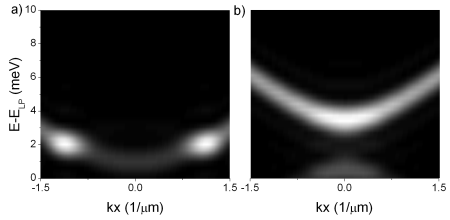 Fig 1. Polariton density as a function of energy and momentum in linear grey scale. |
|
Optical spin Hall effect We observe anisotropy in the polarization flux generated in a GaAs/AlAs photonic cavity by optical illumination, equivalent to spin currents in strongly coupled microcavities. Polarization rotation of the scattered photons around the Rayleigh ring is due to the TE–TM splitting of the cavity mode. Resolving the circular polarization components of the transmission reveals a separation of the polarization flux in momentum space. These observations constitute the optical analogue of the spin Hall effect. 1OSHE: from "Optical analogue of the spin Hall effect in a photonic cavity" Maria Maragkou, Caryl E. Richards, Tomas Ostatnický, Alastair J. D. Grundy, Joanna Zajac, Maxime Hugues, Wolfgang Langbein, and Pavlos G. Lagoudakis Optics Letters, Vol. 36, Issue 7, pp. 1095-1097 (2011) |
 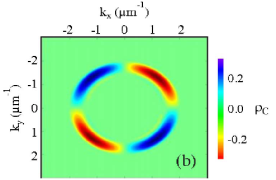 Fig 2. Far-field circular polarization degree measured for x-polarized incident beam tuned at 1:48663 meV equivalent to 15 deg, (b) theoretical calculations for the same conditions. |
|
Investigation of natural defects in microcavitites Polariton states bound
to natural defects in planar GaAs/AlAs microcavities
grown by molecular beam epitaxy were investigated.
The defect
types relevant for the spatial polariton dynamics in
these structures are cross-hatch misfit
dislocations, and point-like defects extended over several
micrometers. We attribute the latter defects to Ga
droplets emitted occasionally by the Ga cell during the
growth. These defects result in a dome-like local modulation of surface,
which is translated into the cavity structure and
leads to a lateral modulation of the cavity polariton energy of up
to 40 meV. The resulting spatially localized
potential landscape for the in-plane polariton
motion creates a
series of bound states. These states were
characterized by spectrally resolved transmission
imaging in real and reciprocal
space, and reveal the spatial potential created by
the defects. Interestingly, the defect states exhibit long lifetimes
between 10-100 ps, which we attribute to a spatially
smooth confinement potential. Moreover, we
investigated these defects using FIB/SEM machine to
cut defects open and expose the
modulation of epilayer, see 2ND.
1ND: "Polariton states bound to defects in GaAs/AlAs planar microcavities" Joanna M Zajac, Wolfgang Langbein, Maxime Hugues, Mark Hopkinson,Phys. Rev. B 85, 165309 (2012) 2ND: OECS12 conference poster, Joanna Zajac, Wolfgang Langbein Fig 3. (on the right)
Real and energy resolved transmission from a natural
defect in the 1st,2nd,4th and 5th column. In 3d and
6th column, real space distributions of
corresponding squares of Mathieu functions labeled by their
parity ('e' even, 'o' odd), radial (n) and angular (m) order.
|
|
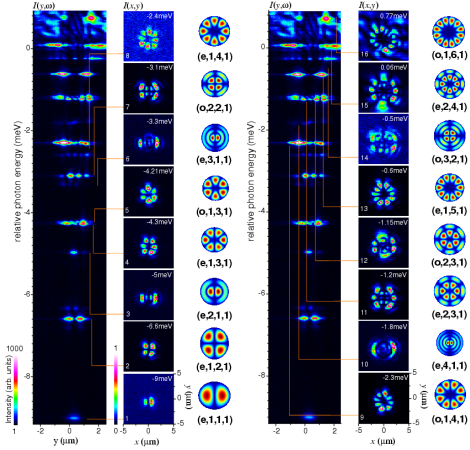 |
Design growth and characterization of strain compensated samples Semiconductor
heterostructures consisting of alternating
binary-alloys with zincblende structure grown in
[001] direction which have moderate lattice
mismatch(<2%) accommodate stress by
the development of a cross-hatch dislocation
pattern. In GaAs based planar microcavities grown
by molecular beam epitaxy (MBE), cross-hatches
create a potential landscape for exciton-polaritons,
causing scattering and localization [1SC].
1SC: OECS10 conference poster, Wolfgang Langbein, here |
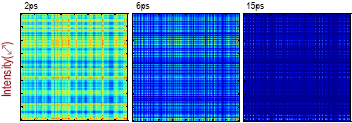 |
|
Parametric scattering of microcavity polaritons Parametric scattering
of microcavity polaritons, similarly to parametric
processes in non-linear crystal, is a consequence of
energy-momentum selection rules for
polaritons in microcavities. Parametric scattering
was observed in strongly coupled GaAs/AlAs based
microcavity. Polaritonic dispersion for "ghost
branches" are symmetrical vs the pump laser energy
and momentum.
Fig 5. (on the right)
Spectrally and directionally resolved emission from
strongly coupled microcavity with LP, LP*, MP and MP*
branches for two pump energies and wavevectors.
back |
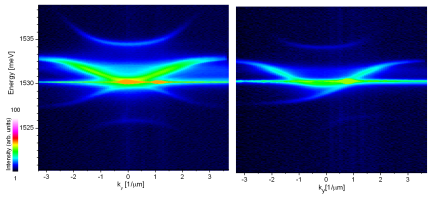 |